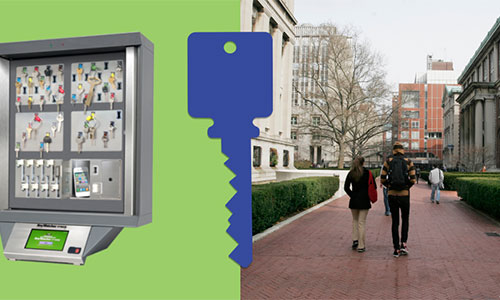When you stop to observe how many keys are used for all the locks at sprawling educational, healthcare, or corporate campus environments, you will find that there are literally thousands of them. All it takes is one lost key to expose risk of potential threats and security breaches. Precluding any potential campus emergency or natural disaster, it is imperative to always know where all facility keys are so first responders can take necessary actions quickly.
Campuses face a variety of security threats around-the-clock. For this reason, campus emergency plans need key control and asset management technology to reduce or eliminate vulnerabilities on campus. Using key control technology maximizes security and safety as an important component of a complete security plan.
Electronic key control systems secure all campus keys within access-controlled key cabinets. Authorized users gain access to their keys with their PIN code, access card, or through biometric identification. When keys are returned, the system’s electronic locking device secures each key within the cabinet. Additionally, all key transactions are recorded such as who removed a key, and where and when it has been returned.
Let’s examine three critical elements electronic key control provides to campus security and first responders:
Key Control Promotes Security Planning
Auditing and improving security measures for campus safety must always include strategies to assist first responders as they arrive on site during emergencies such as fires, floods, evacuations, or active shooter situations. Well-defined procedures with strategically located and networked key control systems make it possible for first responders to act quickly, saving lives, and preventing thousands or millions of dollars in damages.
Pre-activated identification badges distributed to first responders allow for speedy access to necessary keys at strategically located key control cabinets throughout a campus. Key control systems allow first responders to open doors to sensitive areas of buildings, such as laboratories and mechanical rooms, to immediately manage damage control during electrical or structural fires, floods, or active shooter situations.
Key Control Provides Information
Electronic key control provides an additional layer of security and information for first responders. Networked systems transmit activity information to a central location where all key transactions can be monitored and administered remotely through desktops, laptops, and mobile devices.
Immediate confirmation of where all keys are located and identifying who has possession of them leaves an audit trail, which is critical information for security personnel and first responders. When electronic key control is integrated with access control systems, security administrators and first responders receive a bigger picture of actual-time security. Information that is synchronized and shared allows for faster security response time, which is so critical to save lives.
Key Control Maximizes Security Protocol
Campus populations change daily. Without adequate key control measures in place, misplaced keys can result in serious security breaches. Valuable time can also be lost when emergency situations arise. Electronic key control systems maintain strict accountability for keys and prevent key misuse, duplication, and distribution.
Time is of the essence for first responders. Current and reliable information provided by a key control system allows for emergency preparedness and for expediting pre-shared procedures to protect populations on campuses around the world.
Morse Watchmans is the original developer and leader of electronic key control and has authorized representatives globally.








